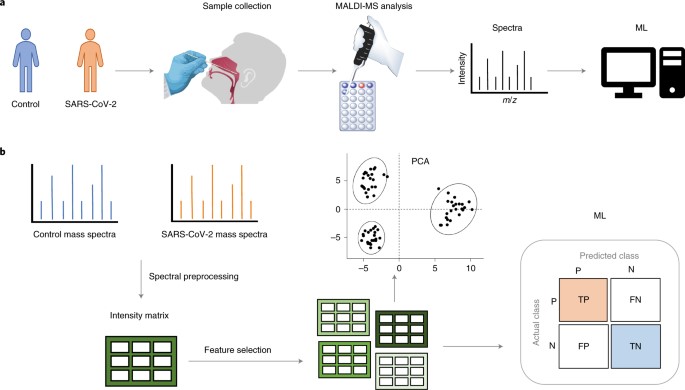Search Product
Structure Search
Search
Advantage Products
Location: Industrial Info
Detection of SARS-CoV-2 in nasal swabs using MALDI-MS
The COVID-19 epidemic has made people realize the importance of in vitro diagnosis in epidemic prevention and control and disease diagnosis, and has also made "nucleic acid detection (RT-PCR)" a familiar term for thousands of households. Recently, Chilean researchers proposed a method to detect SARS-CoV-2 in nasal swabs using matrix-assisted laser desorption/ionization mass spectrometry (MALDI-MS) and machine learning analysis.
Nucleic acid detection is the most extensive and accurate method for the new coronavirus (SARS-CoV-2), and is considered the gold standard for diagnosing new coronary pneumonia. However, the nucleic acid detection (RT-PCR method) of the new coronavirus has a complicated operation process, including sample collection and reception. , Nucleic acid extraction, RT-PCR system configuration, RT-PCR on-machine and other operating steps, and the entire process has strict requirements on laboratory environment, equipment, and personnel operating skills. In some cases, the epidemic situation is still severe but resources are relatively In deprived countries, there are not enough conditions to support the development of nucleic acid testing.

Therefore, researchers hope to use matrix-assisted laser desorption/ionization mass spectrometry (MALDI-MS) equipment and machine learning analysis methods commonly found in clinical laboratories in developing countries to complete the detection of SARS-CoV-2.
Matrix-assisted laser desorption/ionization mass spectrometry (MALDI-MS) is a kind of soft ionization biological mass spectrometry, which is suitable for the determination of molecular weight of mixtures, biological macromolecules, and organic small molecule compounds.
Researchers obtained mass spectra from a total of 362 samples (211 SARS-CoV-2-positive and 151 negative by RT–PCR) without prior sample preparation from three different laboratories. We tested two feature selection methods and six machine learning approaches to identify the top performing analysis approaches and determine the accuracy of SARS-CoV-2 detection. The support vector machine model provided the highest accuracy (93.9%), with 7% false positives and 5% false negatives.
The results suggest that MALDI-MS and machine learning analysis can be used to reliably detect SARS-CoV-2 in nasal swab .
Reference: Fabiane M. Nachtigall, Alfredo Pereira, Oleksandra S. Trofymchuk, Leonardo S. Santos, Detection of SARS-CoV-2 in nasal swabs using MALDI-MS. Nature Biotechnology, 2020. DOI: 10.1038/s41587-020-0644 -7












